24 h Evolution of an Exceptional HONO Plume Emitted by the Record-Breaking 2019/2020 Australian Wildfire Tracked from Space
Abstract
:1. Introduction
2. Materials and Methods
2.1. Satellite Instruments
2.1.1. IASI
2.1.2. CrIS
2.2. HONO Spectral Ratio and Retrieval Method
2.3. Forward Trajectories Simulations
2.4. CHIMERE
3. Results and Discussion
3.1. HONO Detection during the Australian Black Summer
3.2. Trajectories Analysis
3.3. HONO Retrievals Analysis
3.4. Comparison with Model Simulations
4. Conclusions
Supplementary Materials
Author Contributions
Funding
Data Availability Statement
Acknowledgments
Conflicts of Interest
References
- Finlayson-Pitts, B.; Pitts, J., Jr. Chemistry of the Upper and Lower Atmosphere, 1st ed.; Academic Press: Cambridge, MA, USA, 1999; ISBN 978-0-12-257060-5. [Google Scholar]
- Aumont, B.; Chervier, F.; Laval, S. Contribution of HONO Sources to the NOx/HOx/O3 Chemistry in the Polluted Boundary Layer. Atmos. Environ. 2003, 37, 487–498. [Google Scholar] [CrossRef]
- Stemmler, K.; Ammann, M.; Donders, C.; Kleffmann, J.; George, C. Photosensitized Reduction of Nitrogen Dioxide on Humic Acid as a Source of Nitrous Acid. Nature 2006, 440, 195–198. [Google Scholar] [CrossRef] [PubMed]
- Kleffmann, J. Daytime Sources of Nitrous Acid (HONO) in the Atmospheric Boundary Layer. ChemPhysChem 2007, 8, 1137–1144. [Google Scholar] [CrossRef] [PubMed]
- Lu, X.; Wang, Y.; Li, J.; Shen, L.; Fung, J.C.H. Evidence of Heterogeneous HONO Formation from Aerosols and the Regional Photochemical Impact of This HONO Source. Environ. Res. Lett. 2018, 13, 114002. [Google Scholar] [CrossRef]
- Neuman, J.A.; Trainer, M.; Brown, S.S.; Min, K.-E.; Nowak, J.B.; Parrish, D.D.; Peischl, J.; Pollack, I.B.; Roberts, J.M.; Ryerson, T.B.; et al. HONO Emission and Production Determined from Airborne Measurements over the Southeast U.S. J. Geophys. Res. Atmos. 2016, 121, 9237–9250. [Google Scholar] [CrossRef]
- Michoud, V.; Colomb, A.; Borbon, A.; Miet, K.; Beekmann, M.; Camredon, M.; Aumont, B.; Perrier, S.; Zapf, P.; Siour, G.; et al. Study of the Unknown HONO Daytime Source at a European Suburban Site during the MEGAPOLI Summer and Winter Field Campaigns. Atmos. Chem. Phys. 2014, 14, 2805–2822. [Google Scholar] [CrossRef]
- Akagi, S.K.; Yokelson, R.J.; Wiedinmyer, C.; Alvarado, M.J.; Reid, J.S.; Karl, T.; Crounse, J.D.; Wennberg, P.O. Emission Factors for Open and Domestic Biomass Burning for Use in Atmospheric Models. Atmos. Chem. Phys. 2011, 11, 4039–4072. [Google Scholar] [CrossRef]
- Peng, Q.; Palm, B.B.; Melander, K.E.; Lee, B.H.; Hall, S.R.; Ullmann, K.; Campos, T.; Weinheimer, A.J.; Apel, E.C.; Hornbrook, R.S.; et al. HONO Emissions from Western U.S. Wildfires Provide Dominant Radical Source in Fresh Wildfire Smoke. Environ. Sci. Technol. 2020, 54, 5954–5963. [Google Scholar] [CrossRef]
- Bourgeois, I.; Peischl, J.; Neuman, J.A.; Brown, S.S.; Allen, H.M.; Campuzano-Jost, P.; Coggon, M.M.; DiGangi, J.P.; Diskin, G.S.; Gilman, J.B.; et al. Comparison of Airborne Measurements of NO, NO2, HONO, NOy and CO during FIREX-AQ. Atmos. Meas. Tech. Discuss. 2022, 15, 4901–4930. [Google Scholar] [CrossRef]
- Kleffmann, J.; Wiesen, P. Technical Note: Quantification of Interferences of Wet Chemical HONO LOPAP Measurements under Simulated Polar Conditions. Atmos. Chem. Phys. 2008, 8, 6813–6822. [Google Scholar] [CrossRef] [Green Version]
- Clarisse, L.; R’Honi, Y.; Coheur, P.F.; Hurtmans, D.; Clerbaux, C. Thermal Infrared Nadir Observations of 24 Atmospheric Gases. Geophys. Res. Lett. 2011, 38, L10802. [Google Scholar] [CrossRef]
- Longueville, H.D.; Clarisse, L.; Whitburn, S.; Franco, B.; Bauduin, S.; Clerbaux, C.; Camy-Peyret, C.; Coheur, P.-F. Identification of Short and Long-Lived Atmospheric Trace Gases from IASI Space Observations. Geophys. Res. Lett. 2021, 48, e2020GL091742. [Google Scholar] [CrossRef]
- Armante, R.; Perrin, A.; Kwabia Tchana, F.; Manceron, L. The N4 Bands at 11 Mm: Linelists for the Trans- and Cis- Conformer Forms of Nitrous Acid (HONO) in the 2019 Version of the GEISA Database*. Mol. Phys. 2021, e1951860. [Google Scholar] [CrossRef]
- Theys, N.; Volkamer, R.; Müller, J.-F.; Zarzana, K.J.; Kille, N.; Clarisse, L.; De Smedt, I.; Lerot, C.; Finkenzeller, H.; Hendrick, F.; et al. Global Nitrous Acid Emissions and Levels of Regional Oxidants Enhanced by Wildfires. Nat. Geosci. 2020, 13, 681–686. [Google Scholar] [CrossRef]
- Boer, M.M.; Resco de Dios, V.; Bradstock, R.A. Unprecedented Burn Area of Australian Mega Forest Fires. Nat. Clim. Chang. 2020, 10, 171–172. [Google Scholar] [CrossRef]
- Bowman, D.; Williamson, G.; Yebra, M.; Lizundia-Loiola, J.; Pettinari, M.L.; Shah, S.; Bradstock, R.; Chuvieco, E. Wildfires: Australia Needs National Monitoring Agency. Nature 2020, 584, 188–191. [Google Scholar] [CrossRef]
- Filkov, A.I.; Ngo, T.; Matthews, S.; Telfer, S.; Penman, T.D. Impact of Australia’s Catastrophic 2019/20 Bushfire Season on Communities and Environment. Retrospective Analysis and Current Trends. J. Saf. Sci. Resil. 2020, 1, 44–56. [Google Scholar] [CrossRef]
- Johnston, F.H.; Borchers-Arriagada, N.; Morgan, G.G.; Jalaludin, B.; Palmer, A.J.; Williamson, G.J.; Bowman, D.M.J.S. Unprecedented Health Costs of Smoke-Related PM2.5 from the 2019–20 Australian Megafires. Nat. Sustain. 2021, 4, 42–47. [Google Scholar] [CrossRef]
- Li, F.; Zhang, X.; Kondragunta, S. Highly Anomalous Fire Emissions from the 2019–2020 Australian Bushfires. Environ. Res. Commun. 2021, 3, 105005. [Google Scholar] [CrossRef]
- Kloss, C.; Sellitto, P.; von Hobe, M.; Berthet, G.; Smale, D.; Krysztofiak, G.; Xue, C.; Qiu, C.; Jégou, F.; Ouerghemmi, I.; et al. Australian Fires 2019–2020: Tropospheric and Stratospheric Pollution Throughout the Whole Fire Season. Front. Environ. Sci. 2021, 9, 220. [Google Scholar] [CrossRef]
- Pope, R.J.; Kerridge, B.J.; Siddans, R.; Latter, B.G.; Chipperfield, M.P.; Arnold, S.R.; Ventress, L.J.; Pimlott, M.A.; Graham, A.M.; Knappett, D.S.; et al. Large Enhancements in Southern Hemisphere Satellite-Observed Trace Gases Due to the 2019/2020 Australian Wildfires. J. Geophys. Res. Atmos. 2021, 126, e2021JD034892. [Google Scholar] [CrossRef]
- Bowman, D.M.J.S.; Kolden, C.A.; Abatzoglou, J.T.; Johnston, F.H.; van der Werf, G.R.; Flannigan, M. Vegetation Fires in the Anthropocene. Nat. Rev. Earth Environ. 2020, 1, 500–515. [Google Scholar] [CrossRef]
- Kablick III, G.P.; Allen, D.R.; Fromm, M.D.; Nedoluha, G.E. Australian PyroCb Smoke Generates Synoptic-Scale Stratospheric Anticyclones. Geophys. Res. Lett. 2020, 47, e2020GL088101. [Google Scholar] [CrossRef]
- Peterson, D.A.; Fromm, M.D.; McRae, R.H.D.; Campbell, J.R.; Hyer, E.J.; Taha, G.; Camacho, C.P.; Kablick, G.P.; Schmidt, C.C.; DeLand, M.T. Australia’s Black Summer Pyrocumulonimbus Super Outbreak Reveals Potential for Increasingly Extreme Stratospheric Smoke Events. npj Clim. Atmos. Sci. 2021, 4, 38. [Google Scholar] [CrossRef]
- Sellitto, P.; Belhadji, R.; Kloss, C.; Legras, B. Radiative impacts of the Australian bushfires 2019–2020—Part 1: Large-scale radiative forcing. Atmos. Chem. Phys. 2022, 22, 9299–9311. [Google Scholar] [CrossRef]
- Clerbaux, C.; Boynard, A.; Clarisse, L.; George, M.; Hadji-Lazaro, J.; Herbin, H.; Hurtmans, D.; Pommier, M.; Razavi, A.; Turquety, S.; et al. Monitoring of Atmospheric Composition Using the Thermal Infrared IASI/MetOp Sounder. Atmos. Chem. Phys. 2009, 9, 6041–6054. [Google Scholar] [CrossRef]
- Han, Y.; Revercomb, H.; Cromp, M.; Gu, D.; Johnson, D.; Mooney, D.; Scott, D.; Strow, L.; Bingham, G.; Borg, L.; et al. Suomi NPP CrIS Measurements, Sensor Data Record Algorithm, Calibration and Validation Activities, and Record Data Quality. J. Geophys. Res. Atmos. 2013, 118, 12734–12748. [Google Scholar] [CrossRef]
- Strow, L.L.; Motteler, H.; Tobin, D.; Revercomb, H.; Hannon, S.; Buijs, H.; Predina, J.; Suwinski, L.; Glumb, R. Spectral Calibration and Validation of the Cross-Track Infrared Sounder on the Suomi NPP Satellite. J. Geophys. Res. Atmos. 2013, 118, 12486–12496. [Google Scholar] [CrossRef]
- Tobin, D.; Revercomb, H.; Knuteson, R.; Taylor, J.; Best, F.; Borg, L.; DeSlover, D.; Martin, G.; Buijs, H.; Esplin, M.; et al. Suomi-NPP CrIS Radiometric Calibration Uncertainty. J. Geophys. Res. Atmos. 2013, 118, 10589–10600. [Google Scholar] [CrossRef]
- Delahaye, T.; Armante, R.; Scott, N.A.; Jacquinet-Husson, N.; Chédin, A.; Crépeau, L.; Crevoisier, C.; Douet, V.; Perrin, A.; Barbe, A.; et al. The 2020 Edition of the GEISA Spectroscopic Database. J. Mol. Spectrosc. 2021, 380, 111510. [Google Scholar] [CrossRef]
- Rothman, L.S.; Jacquemart, D.; Barbe, A.; Benner, D.C.; Birk, M.; Brown, L.R.; Carleer, M.R.; Chackerian, C., Jr.; Chance, K.; Coudert, L.H.; et al. The HITRAN 2004 Molecular Spectroscopic Database. J. Quant. Spectrosc. Radiat. Transfer 2005, 96, 139–204. [Google Scholar] [CrossRef]
- Stiller, G.P.; von Clarmann, T.; Dudhia, A.; Echle, G.; Funke, B.; Glatthor, N.; Hase, F.; Höpfner, M.; Kellmann, S.; Kemnitzer, H.; et al. The Karlsruhe Optimized and Precise Radiative Transfer Algorithm (KOPRA), Vol. FZKA 6487 of Wissenschaftliche Berichte; Stiller, G.P., Ed.; Forschungszentrum: Karlsruhe, Germany, 2000. [Google Scholar]
- Rodgers, C.D. Inverse Methods for Atmospheric Sounding: Theory and Practice; World Scientific: Singapore, 2000; Volume 2. [Google Scholar]
- Steck, T. Methods for Determining Regularization for Atmospheric Retrieval Problems. Appl. Opt. AO 2002, 41, 1788–1797. [Google Scholar] [CrossRef] [PubMed]
- Skamarock, W.; Klemp, J.; Dudhia, J.; Gill, D.; Barker, D.; Wang, W.; Huang, X.-Y.; Duda, M. A Description of the Advanced Research WRF Version 3; UCAR/NCAR (Boulder, Colorado, US): 2008; p. 1002 KB. UCAR/NCAR: Boulder, CO, USA, 2008; p. 1002 KB. [Google Scholar]
- Menut, L.; Bessagnet, B.; Briant, R.; Cholakian, A.; Couvidat, F.; Mailler, S.; Pennel, R.; Siour, G.; Tuccella, P.; Turquety, S.; et al. The CHIMERE V2020r1 Online Chemistry-Transport Model. Geosci. Model Dev. Discuss. 2021, 14, 6781–6811. [Google Scholar] [CrossRef]
- Granier, C.; Darras, S.; Denier van der Gon, H.; Doubalova, J.; Elguindi, N.; Galle, B.; Gauss, M.; Guevara, M.; Jalkanen, J.-P.; Kuenen, J.; et al. The Copernicus Atmosphere Monitoring Service Global and Regional Emissions (April 2019 Version); Copernicus Atmosphere Monitoring Service (CAMS) report; 2019. [Google Scholar] [CrossRef]
- Kaiser, J.W.; Heil, A.; Andreae, M.O.; Benedetti, A.; Chubarova, N.; Jones, L.; Morcrette, J.-J.; Razinger, M.; Schultz, M.G.; Suttie, M.; et al. Biomass Burning Emissions Estimated with a Global Fire Assimilation System Based on Observed Fire Radiative Power. Biogeosciences 2012, 9, 527–554. [Google Scholar] [CrossRef]
- Sofiev, M.; Ermakova, T.; Vankevich, R. Evaluation of the Smoke-Injection Height from Wild-Land Fires Using Remote-Sensing Data. Atmos. Chem. Phys. 2012, 12, 1995–2006. [Google Scholar] [CrossRef]
- Menut, L.; Flamant, C.; Turquety, S.; Deroubaix, A.; Chazette, P.; Meynadier, R. Impact of Biomass Burning on Pollutant Surface Concentrations in Megacities of the Gulf of Guinea. Atmos. Chem. Phys. 2018, 18, 2687–2707. [Google Scholar] [CrossRef]
- Menut, L.; Bessagnet, B.; Khvorostyanov, D.; Beekmann, M.; Blond, N.; Colette, A.; Coll, I.; Curci, G.; Foret, G.; Hodzic, A.; et al. CHIMERE 2013: A Model for Regional Atmospheric Composition Modelling. Geosci. Model Dev. 2013, 6, 981–1028. [Google Scholar] [CrossRef]
- Wong, K.W.; Tsai, C.; Lefer, B.; Grossberg, N.; Stutz, J. Modeling of Daytime HONO Vertical Gradients during SHARP 2009. Atmos. Chem. Phys. 2013, 13, 3587–3601. [Google Scholar] [CrossRef]
- Liu, J.; Liu, Z.; Ma, Z.; Yang, S.; Yao, D.; Zhao, S.; Hu, B.; Tang, G.; Sun, J.; Cheng, M.; et al. Detailed Budget Analysis of HONO in Beijing, China: Implication on Atmosphere Oxidation Capacity in Polluted Megacity. Atmos. Environ. 2021, 244, 117957. [Google Scholar] [CrossRef]
- Atkinson, R.; Baulch, D.L.; Cox, R.A.; Hampson, J.; Kerr, J.A.C.; Rossi, M.J.; Troe, J. Evaluated Kinetic, Photochemical and Heterogeneous Data for Atmospheric Chemistry: Supplement V, IUPAC Subcommittee on Gas Kinetic Data Evaluation for Atmospheric Chemistry. J. Phys. Chem. Ref. Data 1997, 26, 521–1011. [Google Scholar] [CrossRef]
- Burkholder, J.B.; Sander, S.P.; Abbat, J.; Barker, J.R.; Huie, R.E.; Kolb, C.E.; Kurylo, M.J.; Orkin, V.L.; Wilmouth, D.M.; Wine, P.H. Chemical Kinetics and Photochemical Data for Use in Atmospheric Studies; Jet Propulsion Laboratory: Pasadena, CA, USA, 2015. [Google Scholar]
- Tang, Y.; An, J.; Li, Y.; Wang, F. Uncertainty in the Uptake Coefficient for HONO Formation on Soot and Its Impacts on Concentrations of Major Chemical Components in the Beijing–Tianjin–Hebei Region. Atmos. Environ. 2014, 84, 163–171. [Google Scholar] [CrossRef]
- Lachatre, M.; Mailler, S.; Menut, L.; Turquety, S.; Sellitto, P.; Guermazi, H.; Salerno, G.; Caltabiano, T.; Carboni, E. New Strategies for Vertical Transport in Chemistry Transport Models: Application to the Case of the Mount Etna Eruption on 18 March 2012 with CHIMERE V2017r4. Geosci. Model Dev. 2020, 13, 5707–5723. [Google Scholar] [CrossRef]
- Chakrabarty, R.K.; Beres, N.D.; Moosmüller, H.; China, S.; Mazzoleni, C.; Dubey, M.K.; Liu, L.; Mishchenko, M.I. Soot Superaggregates from Flaming Wildfires and Their Direct Radiative Forcing. Sci. Rep. 2014, 4, 5508. [Google Scholar] [CrossRef] [PubMed] [Green Version]


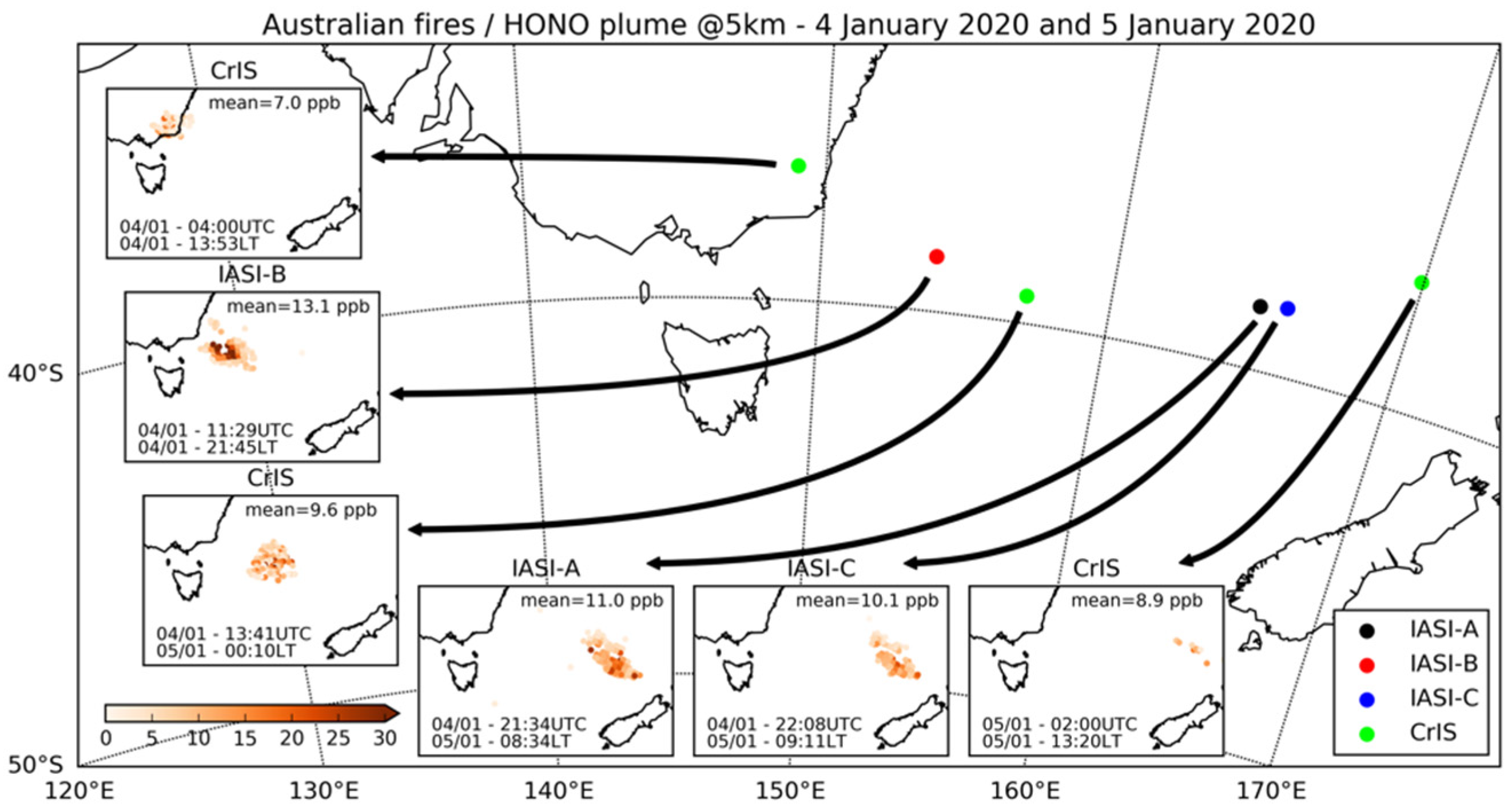
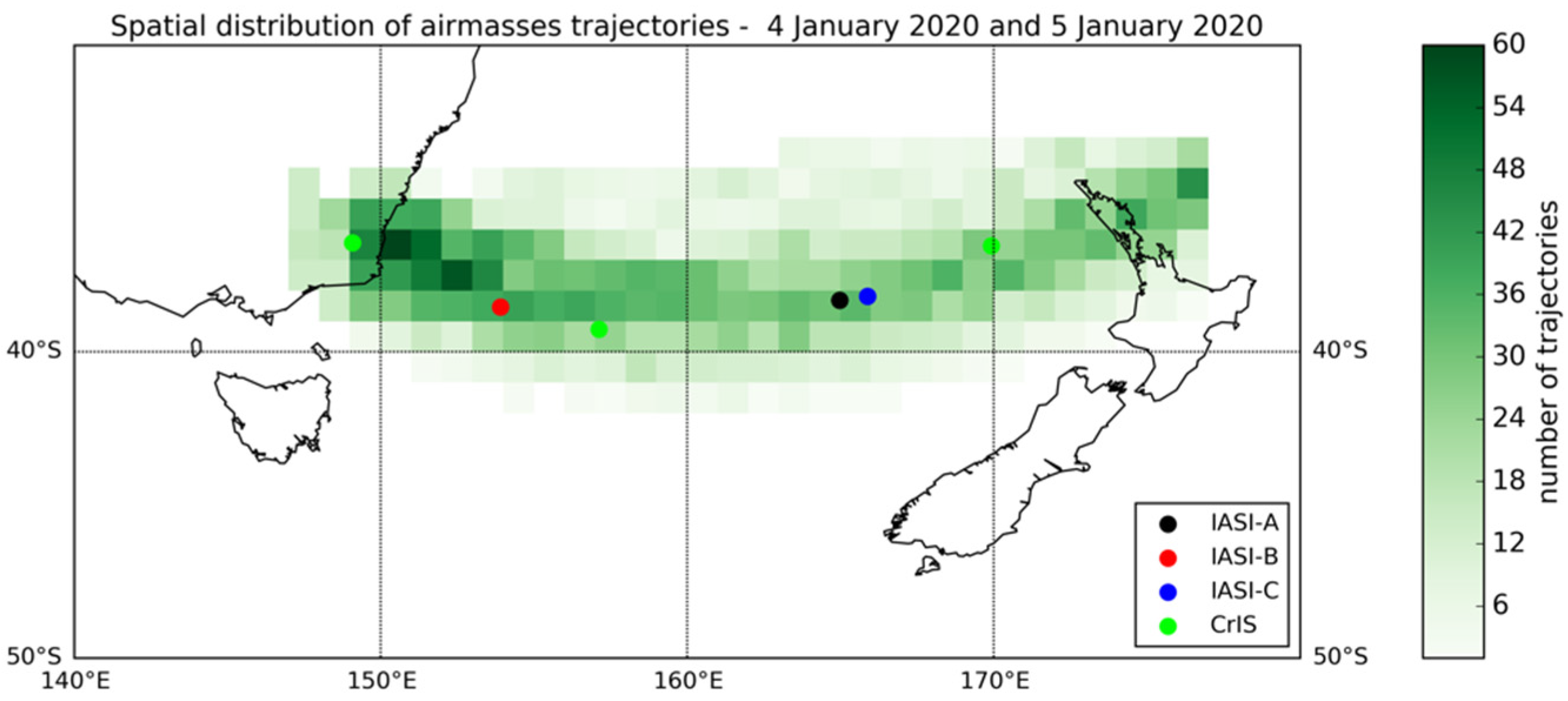

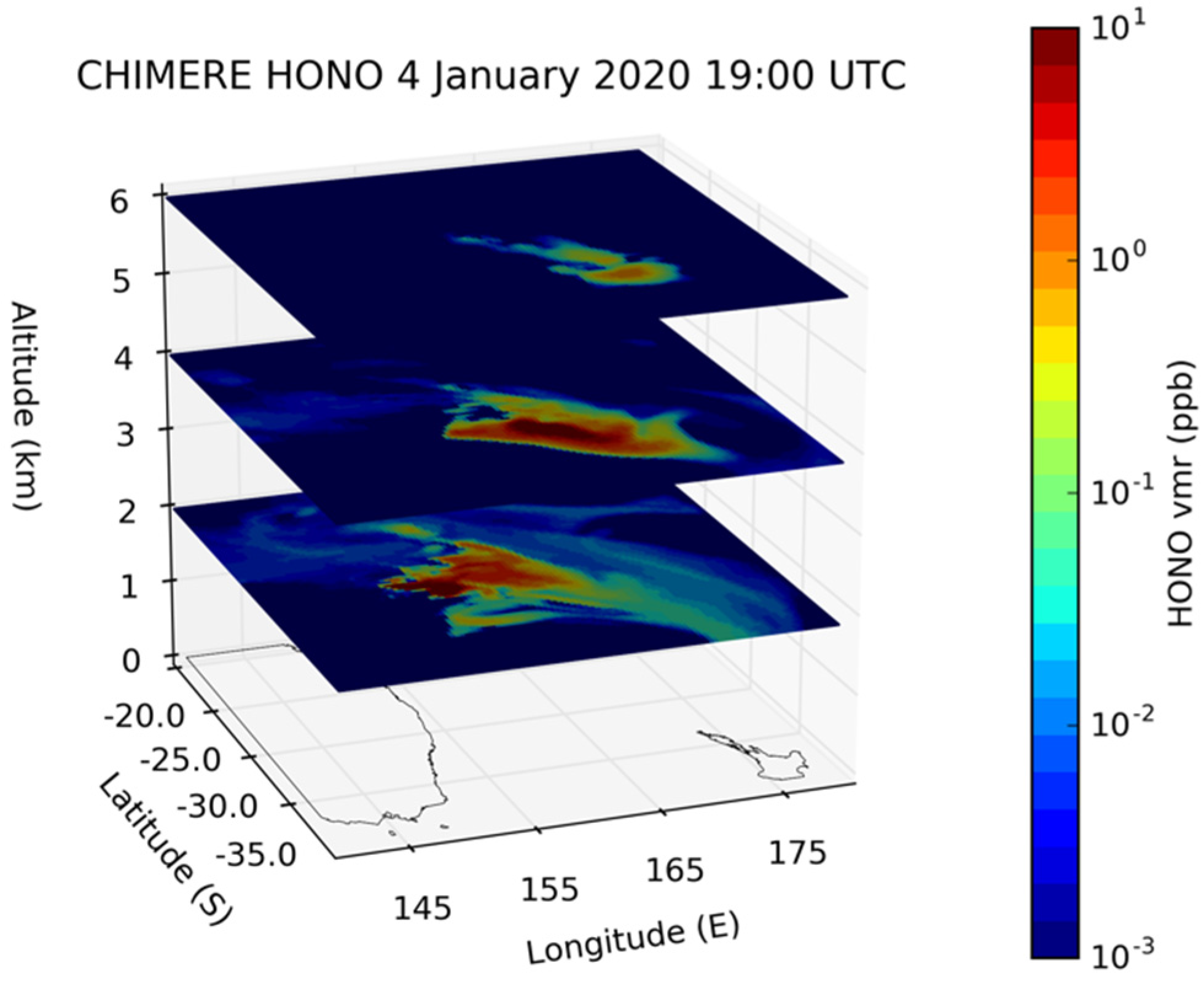
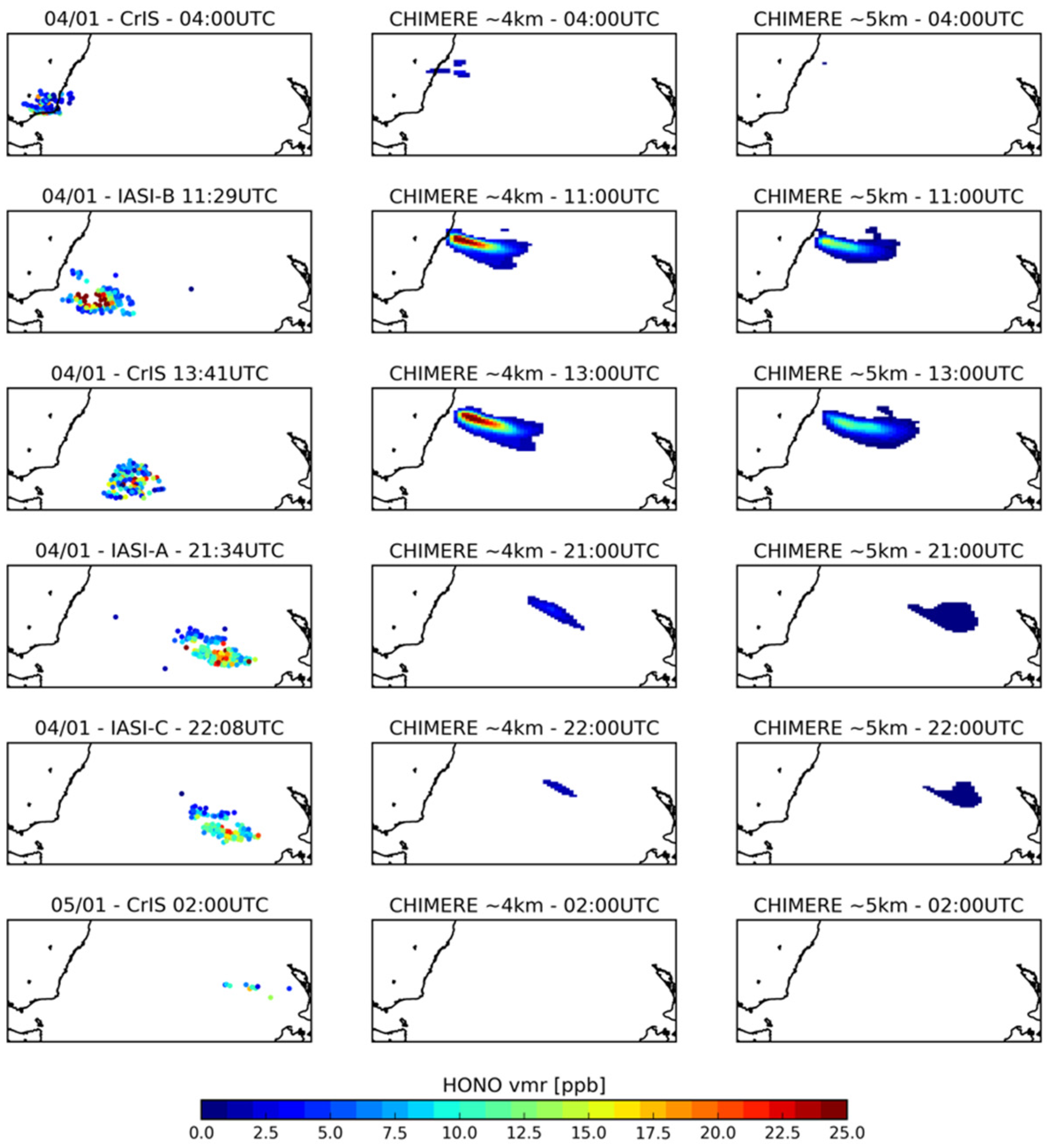
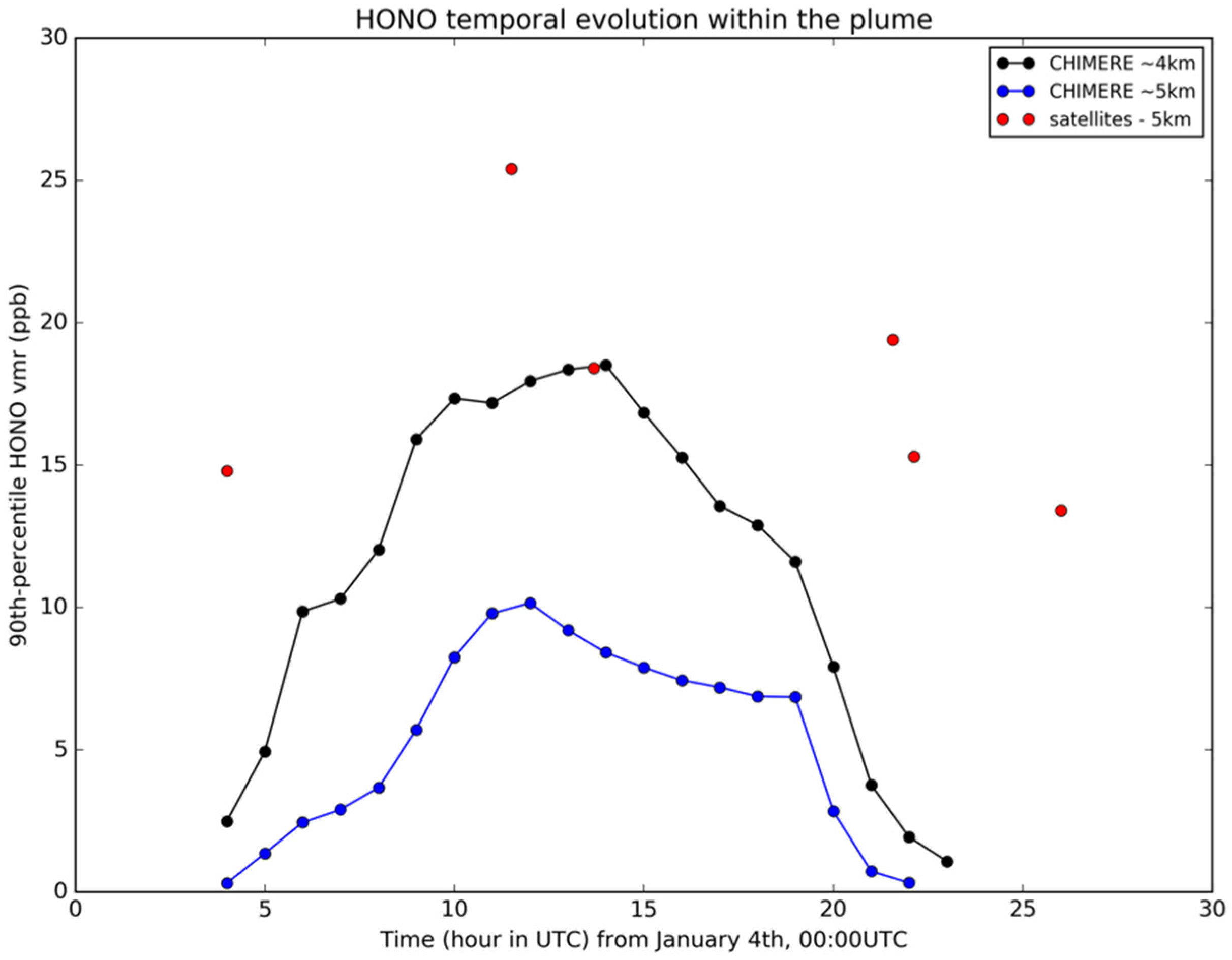
| Reactions | Reaction Constants | References | |
|---|---|---|---|
| R1 | NO + OH + M ➔ HONO | A0 = 7 × 10−31, B0 = 0, n0 = 2.6 A∞ = 1.5 × 10−11, B∞ = 0, n∞ = 0.5 f = 0.6 | Atkinson et al. [45] |
| R2 | HONO + OH ➔ NO2 | k(T) = Ae−B/T A = 1.8 × 10−11, B = 390 | Atkinson et al. [45] |
| R3 | HONO + hν ➔ NO + OH | JHONO | Burkholder et al. [46] |
| R4 | NO2 ➔ HONO | ks = 0.5 × depo(NO2) | Aumont et al. [2] |
| R5 | NO2 ➔ 0.5 × HONO + 0.5 × HNO3 | γ = 5 × 10−5 | Tang et al. [47] |
| R6 | NO2 + hν ➔ HONO | γ = 1 × 10−3 | Wong et al. [43] |
| Satellite Instrument | Date | Time (UTC) | Mean Concentration (ppb) | 90-Percentile (ppb) |
|---|---|---|---|---|
| CrIS | 4 January 2020 | 04:00 | 7.0 | 14.8 |
| IASI-B | 4 January 2020 | 11:29 | 13.1 | 25.4 |
| CrIS | 4 January 2020 | 13:41 | 9.6 | 18.4 |
| IASI-A | 4 January 2020 | 21:34 | 11.0 | 19.4 |
| IASI-C | 4 January 2020 | 22:08 | 10.1 | 15.3 |
| CrIS | 5 January 2020 | 02:00 | 8.9 | 13.4 |
Publisher’s Note: MDPI stays neutral with regard to jurisdictional claims in published maps and institutional affiliations. |
© 2022 by the authors. Licensee MDPI, Basel, Switzerland. This article is an open access article distributed under the terms and conditions of the Creative Commons Attribution (CC BY) license (https://creativecommons.org/licenses/by/4.0/).
Share and Cite
Dufour, G.; Eremenko, M.; Siour, G.; Sellitto, P.; Cuesta, J.; Perrin, A.; Beekmann, M. 24 h Evolution of an Exceptional HONO Plume Emitted by the Record-Breaking 2019/2020 Australian Wildfire Tracked from Space. Atmosphere 2022, 13, 1485. https://doi.org/10.3390/atmos13091485
Dufour G, Eremenko M, Siour G, Sellitto P, Cuesta J, Perrin A, Beekmann M. 24 h Evolution of an Exceptional HONO Plume Emitted by the Record-Breaking 2019/2020 Australian Wildfire Tracked from Space. Atmosphere. 2022; 13(9):1485. https://doi.org/10.3390/atmos13091485
Chicago/Turabian StyleDufour, Gaëlle, Maxim Eremenko, Guillaume Siour, Pasquale Sellitto, Juan Cuesta, Agnès Perrin, and Matthias Beekmann. 2022. "24 h Evolution of an Exceptional HONO Plume Emitted by the Record-Breaking 2019/2020 Australian Wildfire Tracked from Space" Atmosphere 13, no. 9: 1485. https://doi.org/10.3390/atmos13091485
APA StyleDufour, G., Eremenko, M., Siour, G., Sellitto, P., Cuesta, J., Perrin, A., & Beekmann, M. (2022). 24 h Evolution of an Exceptional HONO Plume Emitted by the Record-Breaking 2019/2020 Australian Wildfire Tracked from Space. Atmosphere, 13(9), 1485. https://doi.org/10.3390/atmos13091485







